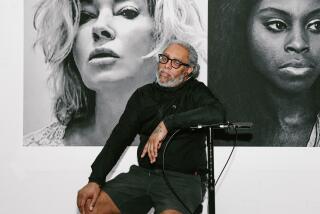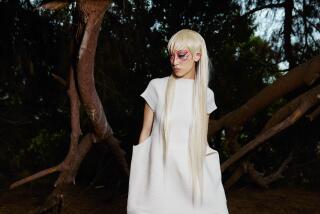Review: An expressive slowness to Jacaranda, Sankai Juku performances

Slowness is catching on quickly. Mostly, this is as an anesthetic to the ever-accelerating pace of change in nearly every aspect of our lives, to say nothing of proliferating distractions. So sensory deprivation chambers are back; yoga classes multiply; retreat vacations are a booming business. But such things serve mainly as rejuvenation for getting back into the fray.
David Lang’s “darker,” a slow and quiet piece for a dozen strings in which very little changes and during which the emotional temperature remains tepid, lasted an hour and seven minutes on Saturday night. It opened the new season of Jacaranda, the new music series at First Presbyterian Church of Santa Monica. The concert began with nine bagpipers keening loudly but also slowly, first on the Santa Monica Palisades overlooking the Pacific, then again in the church courtyard. This was Julia Wolfe’s 15-minute “LAD.”
SIGN UP for the free Classic Hollywood newsletter >>
The night before, Sankai Juku, a Japanese butoh-inspired dance troupe, painstakingly measured the passing time with “Umusuna — Memories Before History.” A funnel of sand fell onstage throughout the 90-minute performance at UCLA. The theme was the transience of seasons, which change but which are also eternal. The dancers’ shaved heads were covered in white paint, diminishing individuality. They moved with calm, measured grace.
These are examples of another kind of slowness. Time is not stopped. No piece felt any longer or shorter than it was. But the remarkable feature of each was the way the length didn’t particularly matter. What did matter was that the intention was not to escape anything, but to be in the moment.
“LAD” and “darker” memorialize friends of Wolfe and Lang, two of the three founders of the experimental music collective Bang on a Can. Slowness is, of course, a traditional device of remembrance. Death requires us to take stock. Death’s presence can make us both more appreciative of our surroundings yet make them feel meaningless.
Played just after sunset at the end of Wilshire Boulevard, “LAD” curiously attracted very few passersby. Maybe the appearance of nine bagpipers in kilts making a startling noise surrounded by cultish new musickers was just too weird a contrast to the more expected Saturday-night entertainments at the Third Street Promenade, two blocks away.
Bagpipes are, indeed, loud, and they are rarely used in nontraditional ways. In “LAD,” Wolfe — a Pulitzer Prize winner whose “Steel Hammer” will be staged this weekend as part of a Bang on a Can All-Stars residency at UCLA — uses them in nontraditional ways.
“LAD” starts softly, almost like an Indian raga, setting the stage. But as the droning begins, volume and pitch rise together, like the sound of giant balloons loosing air as they ascend. The process repeats again and again, and as more bagpipes join in, the visceral power of vibrations electrifies the atmosphere. In the distance, waves crashed on the sand. The second part is the keening, which become increasingly ecstatic calls. The bagpipes were no longer sensed as an alien force but were part of the environment.
For Lang’s “darker,” pairs of violas and cellos were seated like a string quartet while seven violins and a bass stood behind. The lights in the sanctuary gradually and effectively darkened throughout the performance (artist Suzanne Bocanegra has made projections that can accompany “darker” and that were used in a performance last summer at the Massachusetts Museum of Contemporary Art, but not in Santa Monica). Jacaranda’s music director, Mark Alan Hilt, conducted.
Throughout the slow process of “darker,” the lower instruments play very measured sequences of individual notes that don’t quite make a melody. What changes isn’t much, either in pitch or duration, but nothing is ever the same, either. The dynamics remain fairly steady. The upper strings offer fluttery repeated notes that fall somewhere between accompaniment and halo.
There are expressive dynamic swells in both the upper and lower parts. These also are subtle. Nor does anything dramatic happen with the tempo.
The point is to be expressive, but not too expressive, to find a middle way. But that middle way is oddly intense. You may fade in and out of attentiveness to the music. There is nothing you really need to follow, just as you may, while examining a Calder mobile from many angles, momentarily look away. You know that when you come back to it, it will still be there and it will be the same mobile even as it’s moved.
The result, especially given an absorbing performance and sensitive amplification that produced a gleamingly energizing sound, can be one of well being. The moderating slowness of “darkness” is not meditation. Nor is it avoiding speed. Instead, the score offers just enough interest to sort of stay with it, but maybe throw in a few enhancements of your own perceptions. Once that happens, things can get pretty busy.
Sankai Juku’s lack of narrative and the sheer beauty of its movement, light and stage picture accomplish much the same. As in “darker,” “Umusuna” is art in lock step. The eight dancers could almost be clones of Ushio Amagatsu, the dancer who founded the company and who is responsible for choreography, concept and direction. The men are sexless (they wear both male and female costumes). They look alike, move alike, emote alike.
Yet their peculiar ritual gives the impression of being an utterly natural process. The sand falling on the stage looks like a gift from heaven. It builds up. Some of it is swept away. Erosion and renewal are celebrated.
The dancers may seem like creatures of processes we don’t always understand. But they ask for our wonder. It takes a moment (or more like 90 moments) to figure that out. You can’t rush wonder.
More to Read
The biggest entertainment stories
Get our big stories about Hollywood, film, television, music, arts, culture and more right in your inbox as soon as they publish.
You may occasionally receive promotional content from the Los Angeles Times.







